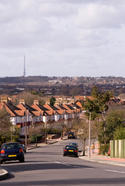Cities today have more political clout than at any time in a half century. Not only does an urbanite blessed by the Chicago machine sit in the White House, but Congress is now dominated by Democratic politicians hailing from either cities or inner-ring suburbs.
Perhaps because of this representation, some are calling for the administration and Congress to "bail out" urban America. Yet there's grave danger in heeding this call. Hope that "the urban president" will solve inner-city problems could end up diverting cities from the kind of radical reforms necessary to thrive in the coming decades.
Demographics and economics make self-help a necessity. read more »






















